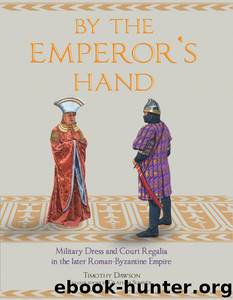By the Emperor's Hand: Military Dress and Court Regalia in the later Romano- Byzantine Empire by Timothy Dawson & Graham Sumner

Author:Timothy Dawson & Graham Sumner [Dawson, Timothy]
Language: eng
Format: epub
Tags: HISTORY / Military / Weapons
ISBN: 9781848324633
Publisher: Frontline Books
Published: 2015-09-29T21:00:00+00:00
FIG. 56. Longinus, the centurion at the Crucifixion, depicted in the guise of the doungarios of the watch, the head of the Constantinopolitan police. Eleventh century. Mosaic, Church of Nea Moni, Khios.
WOMEN
The very scanty information that exists tends to suggest the elite clothing and regalia practices of women in place in the tenth century underwent little change in this period. The text of the will of Kouropalatissa Kalê Pakourianê written in 1081 makes a great deal of recording the status of both Pakourianê’s male connections, and the women to whom she bequeathed items. By this date the rank of kouropalatês had slipped significantly from its once-exalted position, and it seems likely that if had Pakourianê also held either of the two distinctly female ranks of zôstê patrikia or koubikoularea (if either still existed) it would have been mentioned.123 In fact, Pakourianê’s will contains nothing which can be even conjectured as being regalia of her own, but many opulent items which would certainly not have looked out of place at court. As noted at the beginning of the chapter, in terms of more literary works, the practice of ‘Atticism’ denies us contemporary terminology, although at times the lengths the authors have gone to in order to avoid contemporary language can itself be informative.
Common items
Headgear
The large, flaring hat which was previously identified as the propolôma becomes quite frequently illustrated in eleventh- and twelfth-century manuscripts.124 In the tenth century white propolômata were worn by three ranks, zôstai, magistrissai and patrikiai, and by the ladies-in-waiting (koubikoulareai) – by far the great majority of the female population of the court – and there is no reason to assume this had changed. In the eleventh century on occasion they exhibited considerable ornamentation, which was quite a change from the stark white suggested by the Book of Ceremonies, and the simple, white-based style of the late twelfth century (fig. 51).
The propolômata shown on the round of Miriam and the Israelite women, dated to around 1059, are purple with gold decoration.125 These colours are likely to imply that these women were members of the extended royal family, or of the very highest of the non-imperial ranks. Overlying this base colour there were bands of decoration which might run across the hat horizontally, diagonally, or crossing. In the earlier pictures, such as the virgin of the Smyrna Octateuch and especially the dancing circle of Miriam, the distribution of the bands of decoration suggest that they were at that time purely ornamental. The only case of a woman wearing a propolôma whose rank is known to us is Irênê Gavraina, a donor of a tetraevangelion, who was a common patrikia in keeping with the rank of her husband and co-donor.126 The decor on Irênê Gavraina’s propolôma is a single pale-blue band which slants across almost the entire width of the hat on a low diagonal, just as on some of the Israelite women. However, this picture does date from 1067, within the period in which the decor was probably still ornamental rather than symbolic.
Download
This site does not store any files on its server. We only index and link to content provided by other sites. Please contact the content providers to delete copyright contents if any and email us, we'll remove relevant links or contents immediately.
| Advertising | Annuals |
| Book Design | Branding & Logo Design |
| Fashion Design | Illustration |
| Science Illustration |
Wonder by R.J. Palacio(8433)
Mastering Adobe Animate 2023 - Third Edition by Joseph Labrecque(3725)
Unlabel: Selling You Without Selling Out by Marc Ecko(3575)
Ogilvy on Advertising by David Ogilvy(3488)
Hidden Persuasion: 33 psychological influence techniques in advertising by Marc Andrews & Matthijs van Leeuwen & Rick van Baaren(3456)
Drawing Cutting Edge Anatomy by Christopher Hart(3441)
The Pixar Touch by David A. Price(3350)
POP by Steven Heller(3300)
The Code Book by Simon Singh(3059)
The Art of War Visualized by Jessica Hagy(2933)
Slugfest by Reed Tucker(2925)
The Curated Closet by Anuschka Rees(2900)
Rapid Viz: A New Method for the Rapid Visualization of Ideas by Kurt Hanks & Larry Belliston(2817)
Stacked Decks by The Rotenberg Collection(2797)
365 Days of Wonder by R.J. Palacio(2739)
The Wardrobe Wakeup by Lois Joy Johnson(2721)
Keep Going by Austin Kleon(2684)
Tattoo Art by Doralba Picerno(2586)
Tell Me More by Kelly Corrigan(2580)
